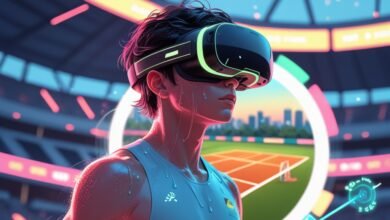Virtual reality in tourism and travel

Virtual reality is changing how we explore the world. It lets us see hotels and national parks in 360 degrees. This makes planning trips more exciting and immersive.
As a traveler, I’ve seen VR become more popular. It lets us visit famous places like the Grand Canyon from home. VR also helps plan trips, making bookings less risky and cultural experiences more meaningful.
Key Takeaways
- VR tools help travelers preview destinations before committing to trips.
- Immersive virtual travel experiences improve decision-making and reduce risk in booking.
- Virtual reality in tourism and travel supports accessibility for those unable to travel physically.
- These technologies offer cost-effective ways to explore global attractions.
- VR supplements real-world travel by providing context and inspiration beforehand.
Introduction to Virtual Reality in Tourism and Travel
Virtual reality in tourism lets travelers see places before they go. It uses headsets or apps to show landmarks, hotels, and landscapes. This tech creates 3D worlds, changing how travel connects with people.
What is Virtual Reality and How Does it Work?
VR uses headsets like Oculus Rift or HTC Vive with motion sensors. It has:
- Head-mounted displays showing 360-degree views
- Spatial audio for real sounds
- Software like Unity or Unreal Engine for digital places
The Evolution of VR Technology in the Travel Industry
| Timeline | Breakthroughs |
|---|---|
| 2010s | Early 360° videos for hotel promotions |
| 2020s | Interactive VR tours for airports and resorts |
| 2023 | A.I.-powered real-time language translation in virtual guides |
Key Players Transforming Tourism Through Virtual Reality
Leading brands include:
- Google Earth VR: Lets you explore global landmarks in 3D
- Marriott’s “Teleporter”: Virtual trips from the office
- Thomas Cook: VR booths in UK stores for vacation previews
These vr tools are now key for marketing and engaging customers.
How VR is Revolutionizing Destination Marketing
Virtual reality is changing how we explore and connect with places. It lets destinations show off through virtual tours that grab attention like nothing else can. For example, Visit Norway’s VR fjord tours or Marriott’s “VR Getaways” create deep connections. These experiences don’t just tell stories; they make you feel like you’re already there.

- Scotland’s “Virtual Highlands” campaign reduced decision-making hesitation, increasing Edinburgh’s tourism inquiries by 35% in 2023.
- Grand Canyon National Park’s VR overlooks led to a 22% rise in advance ticket purchases after virtual previews.
- Japan’s Tourism Agency used VR to showcase winter festivals, boosting US-based search traffic by 40% for Hokkaido tours.
VR helps overcome big challenges like distance and cost. It lets people “try before they buy,” making them more confident in their choices. A 2023 study showed that 68% of users who tried VR felt more sure about booking trips. Even places like Iceland’s VR Northern Lights experiences make it easier to book by showing off seasonal highlights.
VR also helps small places compete with big cities. It lets them show off in a way that feels real and engaging. As more people want to explore before they go, VR is becoming key for places wanting to stand out.
The Different Types of VR Travel Experiences Available Today
Virtual reality lets travelers explore the world in new ways. It’s perfect for before, during, or instead of real trips. Here’s how it meets different needs:

360-Degree Virtual Tours
These tours let you look around in every direction. You can explore museums or national parks from home. Just hover over spots for more info.
Interactive Virtual Destinations
Platforms like TheWaveVR offer adventures where you make choices. You might hike in Iceland or try food in Tokyo. Your decisions change the experience.
Augmented Reality Overlay Experiences
AR apps mix virtual and real worlds. For example, Pokémon GO adds digital creatures to your surroundings. Travel guides like Artivive add animations to real art.
Virtual Reality Hotel Previews
VR lets you see hotels before you book. Marriott’s “Teleporter” shows you room layouts. Booking.com’s VR lets you see resort pools and views.
| Experience Type | Description | Examples |
|---|---|---|
| 360-Degree Tours | Panoramic static views with informational hotspots | Google Earth VR, Visit.org |
| Interactive Destinations | Decision-driven narratives shaping virtual journeys | TheWaveVR, Tokyo virtual tours |
| AR Overlays | Augmented layers over real-world environments | Pokémon GO, Artivive |
| Hotel Previews | 3D walkthroughs of lodging options | Marriott Teleporter, Booking.com VR |
Benefits of VR in Tourism for Travelers
Virtual reality is changing how we plan and experience travel. It offers immersive previews and options for everyone. Let’s look at how it helps.
Also know about How VR and AR Are Used in Surgery

“Try Before You Buy”: Reducing Travel Uncertainty
Imagine checking out a Paris hotel or a Hawaiian resort before booking. Sites like Airbnb and Expedia now have VR previews. This helps avoid bad choices and saves money.
For example, families planning a trip to Disneyland can see attractions online. This helps avoid surprises.
Accessibility for Those with Mobility Constraints
People with mobility issues can now explore places like the Grand Canyon or the Louvre virtually. Museums like the British Museum offer 3D tours. This makes visiting easier without the strain.
VR also includes audio descriptions and customizable speeds. This makes it accessible for everyone.
Budget-Friendly Alternatives to Physical Travel
Students and those on a tight budget use VR to explore places like Machu Picchu or the Great Wall of China. They save on travel costs. Schools like Stanford’s Virtual Human Interaction Lab work with tourism boards to offer these experiences.
Enhancing On-Site Experiences
VR enhances visits to places like Rome’s Colosseum. It adds historical reenactments to empty ruins. Ski resorts like Vail use AR glasses to show trail maps in real time.
These experiences turn passive sightseeing into interactive stories.
How the Hospitality Industry Leverages Virtual Reality Technology
I look into how hotels and resorts use virtual reality technology in hospitality industry to change guest experiences. They use VR for everything from showing off rooms to training staff. This way, guests can see what they’re getting before they even arrive.
- Create 3D room previews for online bookings
- Train staff via simulated guest interaction scenarios
- Offer branded virtual tours to attract niche audiences
Leading brands are at the forefront of this change. For example:
| Hotel Group | VR Application | Outcome |
|---|---|---|
| Marriott | Destination “Postcards” VR experiences | 23% increase in online bookings |
| Hilton | Employee training simulations | 30% faster onboarding for new staff |
| Royal Caribbean Cruises | Cabin virtual walkthroughs | 18% higher customer conversion rates |
These vr applications in travel industry also help keep customers coming back. Training programs cut down on mistakes by 40%. And virtual demos of amenities reduce pre-booking questions by 25%. With 70% of travelers wanting VR previews, the trend is clear.
Case Studies: Successful Implementation of VR in Tourism Destinations
Virtual reality tours are changing how places attract visitors. They offer a new way to see natural wonders and historic sites. An image shows a VR headset in a park, showing this change.
Virtual Reality Tourism in National Parks and Natural Wonders
Zion National Park started VR tours to protect trails. Now, people can see narrow canyons online, reducing foot traffic by 25%. The National Park Service says more people book online, showing VR’s appeal.
Historical Sites and Museums Embracing VR Tech
The British Museum lets you explore ancient Egypt virtually. You can see 3D models of mummies and tombs, increasing interest by 30%. The Colosseum in Rome uses VR to show gladiator battles, making history available worldwide without crowds.
Cities Using VR for Enhanced Urban Tourism
- Singapore: Virtual walking tours of Little India and Marina Bay Sands guide visitors before arrival.
- New York City: VR experiences let tourists preview Broadway shows or explore 9/11 Memorial exhibits before visiting.
- Amsterdam: A VR canal boat tour now complements physical visits, reducing overcrowding in iconic areas.
These cities see 20% more planning before visitors arrive. VR helps plan visits, not replace them.
Challenges and Limitations in Implementing VR Travel Experiences
VR travel experiences have great promise but face big challenges. High costs and missing sensory details are major hurdles. To grow, virtual reality in tourism needs to overcome these issues.
Technology is a big concern. Top-notch headsets like Oculus Rift or HTC Vive are pricey, making them hard to get. Also, making engaging content is costly, hitting small tourism businesses hard.
- Hardware costs exceed $500 for premium headsets
- Software development requires 3D modeling experts
- Only 34% of U.S. households own VR headsets (2023 Pew Research)
Another big challenge is creating real sensory experiences. While visuals can show places, we can’t yet smell Parisian bakeries or feel Hawaiian sand. This gap might make travelers feel like they’re missing out.
| Challenge | Potential Solution |
|---|---|
| Smell/touch limitations | Multi-sensory labs testing odor-emitting devices |
| Device affordability | Public VR kiosks in libraries/malls |
| Economic impact fears | VR as supplementary marketing tool, not replacement |
Destinations should not rely too much on VR. While it’s great for showing off views, it shouldn’t replace real visits. A mix of VR previews and actual experiences might be the best way forward.
The Future of Immersive Virtual Travel Experiences
Immersive virtual travel experiences are changing fast, thanks to new haptic technology and AI. Wearable devices that mimic touch, smell, and temperature are being tested. They make virtual trips feel real.
Soon, AI will guide tours in real time. Imagine a virtual Italian tour that changes based on your interests. It could show you art if you love culture or food if you’re a foodie. This personal touch will make experiences more enjoyable.
Technology is getting cheaper and easier to use. Devices like Meta’s Quest 3 are making VR more accessible. This means even small businesses can offer virtual tours, reaching more people.
Mixed reality could blend digital and real spaces. Imagine walking through a museum with virtual history scenes. This could change how we see landmarks, adding depth without being too much.
But there are big questions about ethics. We need to protect data and think about the environment. The future of VR in travel will depend on finding a balance between innovation and sustainability.
Conclusion: Embracing the Virtual Reality Revolution in Tourism
Virtual reality in tourism is now a reality, changing how places connect with people. It lets tourists explore places virtually, whether to inspire visits or offer alternatives for those who can’t travel. Companies like Marriott and Google Earth are already using VR to reach more people.
For travelers, VR helps by showing what places are like before they go. It lets them see far-off places from home. Places can also use VR to show off landmarks and attract visitors. The goal is to make travel better, not replace it.
As tech gets better, it’s important for travel businesses to use VR well. Hotels and travel agencies should show off their places with 360-degree views. Historic sites can share their stories with people all over the world. Using VR to explore or remember trips adds something special to travel. The future of travel is a mix of virtual and real experiences, making the world more open than ever.





